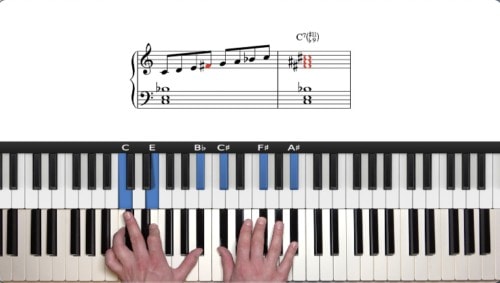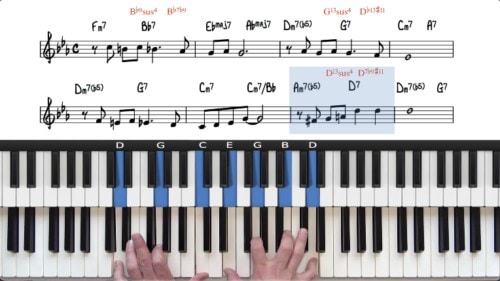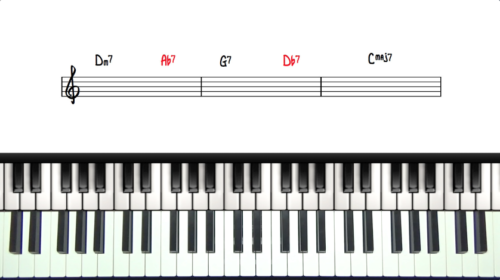Reharmonisation For Beginners
In this lesson we will introduce chord substitutions and reharmonisations for the tune “Georgia On My Mind”.
To create an accessible introduction to reharmonisation I have ensured that all of the reharms that I’m going to show you in this lesson are both logical and easy to follow and understand.
What Is Chord Reharmonisation?
Reharmonisation is when we change the harmony of jazz standards. Just because the lead sheet shows a set of chord changes, this doesn’t mean that these changes are the only chord changes that we can play.
Reharmonisation is a very interesting topic because sometimes reharmonizations do not conform with traditional harmonic principles but at the same time they sound great.
In this lesson we explore the difference between reharmonisations, and simply changing the colour and qualities of the chords.
Why Do We Reharmonise A Tune?
Reharmonisations are useful when we are playing tunes with repetitive harmony. The A Section for Georgia On My Mind repeats 3 times which makes it a great candidate for applying chord substitutions.
In a previous lesson we added passing chords into the harmony, and now we take it a step further with reharmonisation.
Lesson Downloads
-
Reharm Performance File Type: pdf
-
A Section Reharm Examples File Type: pdf
Practice Tips
-
The best reharmonisations keep the original melody note intact, and are harmonically connected to the previous and subsequent chords.
-
The first line is heavily reharmoinsed whereas the second line is embellished by changing the chord colours and qualities.
-
Understand that reharmonisation is not essential, but it is an option to add interest to a repetitive tune.
-
Mix and match the concepts covered in this course to create a balanced and well-rounded arrangement.








Hi Hayden, for some reason neither the “AB” feature nor the control of speed of the video appear in the reader, can you see if you can fix this? Thanks a lot, great lesson but it needs a lot of practice!
Hi Laurent 👋
The controls have been added now – thanks for letting me know.
Cheers,
Hayden
I’m learning to use #11 color chords. I like the concept that “if there is a dominant chord with the root in the melody, we can play the tritone and that results in a #11 in the melody.” This may be a stupid question, but in the last part of this lesson you do that over an Am7 substituting an Eb7#11. The root note of the Am7 is obviously A but the melody note is C. Obviously you mean the C7. What am I missing here?
Hi Wendy 👋
Good question here.
Yes this is a useful relationship to understand. When the root is in the melody over any dominant chord, simply change the bass note to the tritone and keep the 3rd, 7th, and melody note where they are, and we will then have a dominant 7 chord with the #11 in the melody.
The previous example that you mention, I used an upper structure triad (F triad over Eb7) which is replacing the A-7 chord. The A-7 chord leads to D7, and the Eb7 or now Eb13#11 with the F triad on top, is simply a dominant chord a half step above the D7.
Eddie Higgins uses this exact reharmonisation in his arrangement of Over The Rainbow, this time using Eb13#11 as a passing chord in between A-7b5 and D7 in bar 22 – see screenshot. I will explain this in detail in the seminar on Tuesday.
A side note is that this relationship also works over any ii-7 or ii-7b5 chord with the root or minor 3rd in the melody. We simply play the dominant chord a tritone away from the root, and we can use a UST voicing which creates additional colour and a strong pull into the V7 chord which is a half step below.
It’s a little complicated to explain the relationship in a text comment, but as mentioned I will cover in detail in the seminar on Tuesday with some examples in different keys too.
pianogroove.com/live-seminars/eddie-higgins-over-the-rainbow/
I hope the above helps.
Cheers,
Hayden
Hey Hayden,
You mentioned there is a video preceding this lesson that covers chromaticism and gospel voicings. Is that found elsewhere or has it not been created yet?
Thanks!
José
Hi Jose,
Sorry for the late reply.
Yes I had planned to add more lessons to this course and I mention at the end of this video that the next lessons will cover bigger voicings styles in the higher octaves. This is what I’m referring to. These haven’t been created yet but they will be added to this course as soon as they are ready.
I’d also like to add a blues-style improvisation module to this course which will complement the current harmony studies.
After recording the 9 lessons in this course I switched my focus onto the Ballad Fills & Runs course which you can find here if you haven’t already checked it out: pianogroove.com/jazz-piano-lessons/ballad-voicings-fills-improv/ – this course is finished.
I will get around to finishing the bluesy stride course asap.
Let me know if I can help further.
Talk soon,
Hayden
No worries. Thank you! This course has been really helpful as well